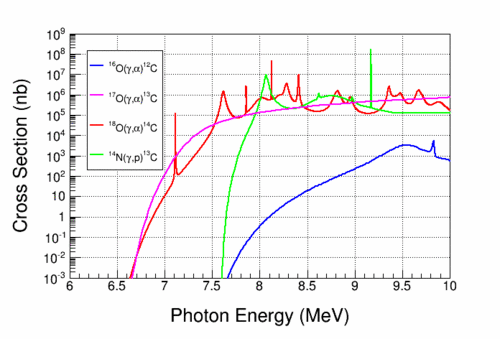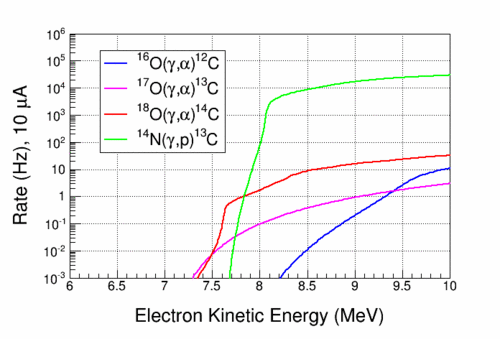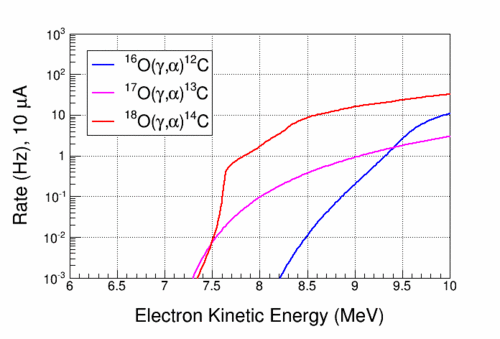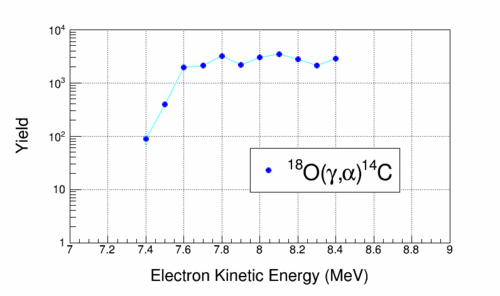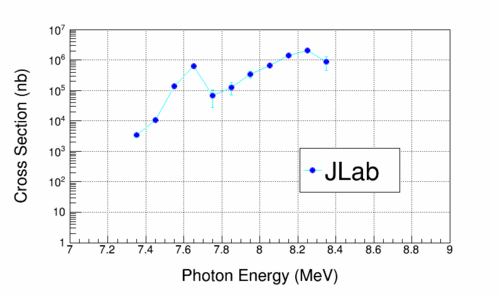Difference between revisions of "Bubble Chamber Beam Test September 2015"
Jump to navigation
Jump to search
| Line 28: | Line 28: | ||
* '''Run Plan:''' | * '''Run Plan:''' | ||
| + | |||
* ''Suppression of <sup>14</sup>N(γ,p)<sup>13</sup>C events:'' | * ''Suppression of <sup>14</sup>N(γ,p)<sup>13</sup>C events:'' | ||
| Line 38: | Line 39: | ||
# At K.E. of 8.5 MeV, increase the chamber threshold by increasing the pressure. Suppress the <sup>14</sup>N(γ,p)<sup>13</sup>C events. | # At K.E. of 8.5 MeV, increase the chamber threshold by increasing the pressure. Suppress the <sup>14</sup>N(γ,p)<sup>13</sup>C events. | ||
# Once <sup>14</sup>N(γ,p)<sup>13</sup>C is suppressed, the rate should drop by three orders of magnitude | # Once <sup>14</sup>N(γ,p)<sup>13</sup>C is suppressed, the rate should drop by three orders of magnitude | ||
| + | |||
* ''Measuring rates from <sup>18</sup>O(γ,α)<sup>14</sup>C:'' | * ''Measuring rates from <sup>18</sup>O(γ,α)<sup>14</sup>C:'' | ||
| Line 47: | Line 49: | ||
# Reproduce the overall rate from oxygen isotopes shown above | # Reproduce the overall rate from oxygen isotopes shown above | ||
# Note the change in slope of rates vs. beam K.E. and the sharp kink around 7.6 MeV | # Note the change in slope of rates vs. beam K.E. and the sharp kink around 7.6 MeV | ||
| + | |||
* ''Measuring <sup>18</sup>O(γ,α)<sup>14</sup>C cross section:'' | * ''Measuring <sup>18</sup>O(γ,α)<sup>14</sup>C cross section:'' | ||
Revision as of 13:52, 6 September 2015
Run Plan
- Chamber is filled with natural N2O
- Cross sections:
The cross sections are shown in the following figure:
- Expected rates:
The expected rates are calculated with 3 cm cell thickness and thin radiator.
- The expected rates are shown in the following figure:
- The expected rates from oxygen isotopes are shown in the following figure:
- Run Plan:
- Suppression of 14N(γ,p)13C events:
- Determine an initial pressure and temperature with no beam
- Start with beam at K.E. 6.5 MeV
- Increase beam K.E. by 0.2 MeV steps all the way to 8.5 MeV
- Adjust beam current to maintain a bubble rate of few per minute
- Reproduce the overall rate shown above
- At K.E. of 8.5 MeV, increase the chamber threshold by increasing the pressure. Suppress the 14N(γ,p)13C events.
- Once 14N(γ,p)13C is suppressed, the rate should drop by three orders of magnitude
- Measuring rates from 18O(γ,α)14C:
- Now the chamber is at the new pressure
- Start with beam at K.E. 7.2 MeV
- Increase beam K.E. by 0.2 MeV steps all the way to 9.2 MeV
- Adjust beam current to maintain a bubble rate of few per minute
- Reproduce the overall rate from oxygen isotopes shown above
- Note the change in slope of rates vs. beam K.E. and the sharp kink around 7.6 MeV
- Measuring 18O(γ,α)14C cross section:
- Start with beam at K.E. 7.4 MeV
- Increase beam K.E. by 0.1 MeV steps all the way to 8.4 MeV
- Adjust beam current to maintain a bubble rate of few per minute
- Perform Penfold-Leiss unfolding
- The expected yield is shown in the following figure:
- The measured cross section using Penfold-Leiss unfolding is shown in the following figure:
